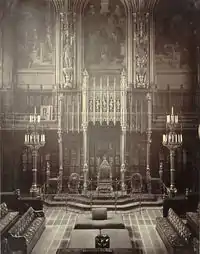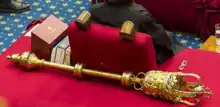Woolsack
The Woolsack is the seat of the Lord Speaker in the House of Lords, the Upper House of the Parliament of the United Kingdom. Before 2006, it was the seat of the Lord Chancellor.

History
In the 14th century King Edward III (1327–1377) said that his Lord Chancellor whilst in council should sit on a wool bale, now known as "The Woolsack", in order to symbolise the central nature and great importance of the wool trade to the economy of England in the Middle Ages.[1][2] Indeed, it was largely to protect the vital English wool trade routes with continental Europe that the Battle of Crécy was fought with the French in 1346.[3]
In 1938, it was discovered that the Woolsack was, in fact, stuffed with horsehair. When it was remade, it was re-stuffed with wool from all over the Commonwealth as a symbol of unity.[4]
From the Middle Ages until 2006, the presiding officer in the House of Lords was the Lord Chancellor and the Woolsack was usually mentioned in association with the office of Lord Chancellor. In July of that year, the function of Lord Speaker was split from that of Lord Chancellor under the Constitutional Reform Act 2005, with the former now sitting on the Woolsack.[5]
Until 1949, Canada's Senate also had a judges' woolsack. At the behest of an MP who decried the use of a cushion on which the judges had to sprawl "like urchins," the woolsack was eventually abolished and replaced with conventional chairs. The original woolsack is still extant.[6]
Ceremonial role
.jpg.webp)
The Woolsack is a large, wool-stuffed cushion covered with red cloth; it has neither a back nor arms, though in the centre of the Woolsack there is a back-rest. The Lords' Mace is placed on the rear part of the Woolsack.[1] The Lord Speaker may speak from the Woolsack when speaking in their capacity as Speaker of the House, but must, if seeking to debate, deliver their remarks either from the left side of the Woolsack, or from the normal seats of the Lords.[7]
If a Deputy Speaker presides in the absence of the Lord Speaker, then that individual uses the Woolsack. However, when the House meets in the "Committee of the Whole", the Woolsack remains unoccupied, and the presiding officer, the Chairman or Deputy Chairman, occupies a chair at the front of the table of the House.[7]

In front of the Woolsack is an even larger cushion known as the Judges' Woolsack.[9] During the State Opening of Parliament, the Judges' Woolsack was historically occupied by the Law Lords. Now the Attorney General, the Solicitor General, the Lord Chief Justice, the Master of the Rolls, the President of the Family Division, the Vice-Chancellor, Justices of the Supreme Court, the Lords Justices of Appeal and the Justices of the High Court only attend Parliament for the State Opening.[10]
Mentions in popular culture
Gilbert and Sullivan's comic opera Iolanthe is partially set in the grounds of the Palace of Westminster the meeting place of the House of Lords and the Lords appear as the male chorus and a fictional Lord Chancellor is a main character. The entire house, as well as the Lord Chancellor, have become attracted to Phyllis, a ward of chancery. The Lord Chancellor laments that fact that propriety would not allow him to marry his own ward, no matter how strongly he may care for her. He describes his position in this way: "Ah, my Lords, it is indeed painful to have to sit upon a woolsack which is stuffed with such thorns as these!"
Dorothy L. Sayers refers to the Woolsack in her book “Lord Peter views the Body” as the hiding place of the Attenbury Emeralds.
Notes
- "Glossary: Woolsack". UK Parliament. Retrieved 25 October 2014.
- Friar 2004, pp. 480–481
- Sumption 1991, pp. 188–189
- "The Lords Chamber". UK Parliament. Retrieved 3 February 2013.
- Gay 2003, p. 16
- "How A Venerable Senate Icon Got The Sack". Senate of Canada. 28 January 2020.
- Great Britain Parliament House of Lords 2010, pp. 38–41
- "The Lord Speaker's Role". Parliament.uk. Retrieved 23 May 2018.
- Great Britain Parliament House of Lords 2013, pp. 30–31 - Plan of the chamber including location of Judges Woolsack
- Great Britain Parliament House of Lords 2013, pp. 17–18
References
- Friar, Stephen (2004). The Sutton Companion to Local History. Sparkford, England: Sutton. ISBN 0-7509-2723-2.
- "Woolsack contents questioned". Courier Mail, Brisbane. 1938. Retrieved 2 February 2013.
- Great Britain Parliament House of Lords (2013). "Companion to the Standing Orders and Guide to the Proceedings of the House of Lords (House of Lords Papers)" (PDF). London: Stationery Office. Retrieved 3 February 2013.
- "The Woolsack". UK Parliament website. Woolsack. Retrieved 30 April 2011.
- The Judges' Woolsack at the UK Parliament site. URL accessed 30 April 2011
- The Interior of the House of Lords at an archived version of the Explore Parliament website. URL accessed 28 February 2011. See also the image at full resolution. The woolsacks are the large, low, rectangular objects in front of the throne, surrounded by ropes. *
- Great Britain Parliament House of Lords (2010). Companion to the Standing Orders and Guide to the Proceedings of the House of Lords (House of Lords Papers). London: Stationery Office Books; 25th edition. ISBN 978-0-1084-7241-1.
- Gay, Oonagh (2003). "Roll of the Lord Chancellor. Standard Note: SN/PC/2105" (PDF). Parliament and Constitution Centre. UK Parliament. Retrieved 2 February 2013.
- Sumption, Jonathan (1991). The Hundred Years War I: Trial by Battle. Philadelphia: University of Pennsylvania Press. ISBN 0-8122-1655-5.
External links
- . Encyclopædia Britannica. 28 (11th ed.). 1911. p. 818.